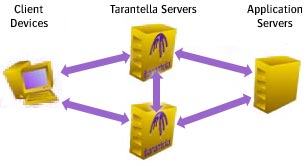
| Read this topic to... |
|---|
|
Tarantella is only one of many components on your network. The information here is related to Tarantella, and can only help raise security levels as part of an ongoing security strategy.
Tarantella connects client devices to application servers, acting as a go-between. Also, Tarantella servers can join together as an array. This means there are three types of connection involved:
| Type | Description |
|---|---|
| Connections between client devices and Tarantella servers |
These may be web server connections (for example, opening the web page that lets you log in to Tarantella) or Tarantella-related connections (used by the Tarantella components running on the client device to connect to the Tarantella server; for example, to send key presses or receive display updates within emulators). |
| Connections between Tarantella servers and application servers |
These are used to start applications on the application server, and to send and receive data from the application, such as key presses and display updates. |
| Connections between Tarantella servers in an array |
These are used to update secondary Tarantella servers with changes made on the primary Tarantella server. |

In a Tarantella installation without the Tarantella Security Pack, all connections are unencrypted (in the clear). This is as secure as using the telnet program to communicate between two UNIX hosts.
You can raise security levels in these ways:
In a Tarantella installation without the Tarantella Security Pack, passwords are encoded between the client device and the Tarantella server to deter casual eavesdroppers. With the Tarantella Security Pack, this information is always encrypted.
Tarantella encrypts all passwords stored in the password cache.
By default, the encryption key used for the password cache never changes. You can force the key to change whenever Tarantella servers start by checking the Generate New Encryption Key On Restart box on the Security panel of Array Manager.